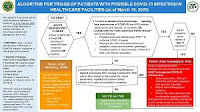Even after the critical-care hurricane passes, we are looking at COVID-19-related thunderstorms for the years ahead.
We are used to thinking about the impact of COVID-19 in light of short-term effects: hospital beds, ventilators, staffing, schools and businesses, local and national economy, etc. It makes perfect sense. These are the places and concerns where the pandemic first hits us. But researchers are starting to look at the longer-term effects, beginning with the health care needs of individuals with long-term and even permanent health problems as a result of their exposure to the novel coronavirus.
Even after (that is, when and if) Reuters ran this story last week:
With mounting evidence that some COVID-19 survivors face months, or possibly years, of debilitating complications, healthcare experts are beginning to study possible long-term costs.
Bruce Lee of the City University of New York (CUNY) Public School of Health estimated that if 20% of the U.S. population contracts the virus, the one-year post-hospitalization costs would be at least $50 billion, before factoring in longer-term care for lingering health problems. Without a vaccine, if 80% of the population became infected, that cost would balloon to $204 billion.
This of course is on top of the year-in, year-out bill for health care B.C. (Before COVID-19). According to the Centers for Medicare and Medicaid Services, "U.S. health care spending grew 4.6 percent in 2018, reaching $3.6 trillion or $11,172 per person. As a share of the nation's Gross Domestic Product, health spending accounted for 17.7 percent."
If we're aiming for herd immunity without a vaccine available, 80% is a good number, but in terms of the human misery, economic dislocation, and impact on health care providers (institutional and individual), getting to 80% is a disaster. And $204 billion represents a 5.67% bump on top of the underlying 4.6% growth rate that is pretty much baked into our national health care costs.
We may get a vaccine that will be at least partially effective, and we may get out the required hundreds of millions of doses (in this country along, let alone the billions needed worldwide). The infection rate, therefore, may be less than 80%. But a 20% infection rate still puts an enormous burden on the system, especially primary-care physicians and specialists including cardiologists, pulmonologists, endocrinologists, neurologists, and gastroenterologists.
And that burden will not be shared equally by states and regions. Massachusetts has more physicians per capita than any other state. There may be shortages in the years ahead, but they are unlikely to be as severe as in states that already have physician and other health-provider shortages. Many of those states are in the South (including the the Southeast and Southwest), where restrictions have been lifted too broadly and too soon and where COVID-19 spikes have been the most pronounced since July.


















